Curator’s note:
Every time I curate a new KINODANCE program, I redefine and rediscover
cine-dance, looking for its traces in both different film genres
and at the crossroads of the art of motion pictures (whether cinema,
video art or even gallery installations) and other art forms. Curating
a festival is similar to making a film, only in the KINODANCE case
the subject matter stays always the same – it is about magnificent
aspects of choreography on screen – choreography as an art
of orchestrating action in space and time. So here are the “episodes”
of KINODANCE 2006 in St. Petersburg:
 Dance
Film Collaboration
Dance
Film Collaboration
(Films, performance, installation by Liz
Aggiss and Billy Cowie (UK))
 Dance
Film History
Dance
Film History
(Gene Kelly
(American Hollywood Cinema) and Ed
Emshwiller (American Avante-Garde Cinema))
 Dance
Film Artist in Focus
Dance
Film Artist in Focus
(David Hinton
(UK) and Charles Atlas
(USA))
 Beyond
the Stage
Beyond
the Stage
(David LaChapelle’s “RIZE”
with krumping from the
streets of Los Angeles)
 From
the Festivals Around the World (some of the best
dance films from recent festivals – including Wim Wandekeybus’
“Blush” and William
From
the Festivals Around the World (some of the best
dance films from recent festivals – including Wim Wandekeybus’
“Blush” and William
Forsythe/Thierry De Mey collaboration “One Flat Thing
Reproduced”)
 Performance
Art in Motion
Performance
Art in Motion
(Marina Abramovic
and Meredith Monk)
 Film
as a Plastic Art: Canvas in Motion
Film
as a Plastic Art: Canvas in Motion
(a
collage of mesmerizing visual dances from animation to video
art)
 Choreography:
Music Video (a collection of
19 spectacularly
Choreography:
Music Video (a collection of
19 spectacularly
choreographed music videos from 9 countries)
 All
Time Favorites
(dance film classics of the popular audience’s demand
including Peter Greenaway’s
“Rosa”, DV8’s
“Cost of Living" and others)
All
Time Favorites
(dance film classics of the popular audience’s demand
including Peter Greenaway’s
“Rosa”, DV8’s
“Cost of Living" and others)
This
year’s KINODANCE is composed of 15
programs of over 60 films by artists from 23 countries
(UK, USA, New Zealand, Belgium, France, Nigeria, Slovenia, Australia,
Canada, Poland, Italy, Japan, Uruguay, Denmark, Mexico as well
as Romania, Poland, Russia, Slovakia, Georgia, Armenia, Estonia
and Hungary). The festival will take
place at Dom Kino, British Council,
and ProArte Institute in St. Petersburg; in Aktoviy Zal of TSEKH
Dance Agency in Moscow and at the Center for Contemporary Art
in Ekaterinburg. For the second time, KINODANCE
will hold a Dance Film Competition
for works created by artists from Eastern Europe, Baltic States
and the CIS (click regulations
 for more info). The winner will be announced at the closing ceremony.
for more info). The winner will be announced at the closing ceremony.
With
gracious support from the Trust
for Mutual Understanding, KINODANCE is thrilled
to welcome Charles Atlas (USA),
a maverick filmmaker from New York who over his prolific life
has created over 100 films and, for over 10 years, collaborated
with legendary modern dance choreographer Merce
Cunningham. Charles Atlas will be teaching a two
day master class at ProArte Institute (check the schedule for
details).
It
is for the first time that KINODANCE is collaborating with the
British Council, one of the key partners of the festival in St.
Petersburg this year. The British Council made it possible for
KINODANCE to host three British artists - David
Hinton, Liz Aggiss and Billy Cowie. Thanks to
the British Council, for the very first time, in addition to film
programs, KINODANCE is also presenting a
dance installation “MAN IN THE WALL” by Aggiss and
Cowie.
The
Opening Program of
the festival as always offers an eclectic selection of shorts
and excerpts from the past and upcoming screenings. The program
will also include some films familiar to the Russian audience
such as excerpts from Sergei Parajanov’s
films as remarkable examples of choreography for the camera. Without
a doubt, Parajanov was one the greatest film choreographers of
all times.
«Program
1: 20 years of collaboration, Liz Aggiss and Billy Cowie»
is an evening with two splendid artists- composer/filmmaker Billy
Cowie and choreographer/performer/ interdisciplinary
artist Liz Aggiss
from Brighton, England. The evening includes a provocative and
full of humor dance “lecture”-performance
that is based on the experimental and fictional dancer Heidi Dhinkowska
(also known as Hi Jinx) who, according to Liz
and Billy, is also the foremother of “cine-dance”
genre. The creative couple will also show and discuss their four
award-winning films – the spectacular
“Motion Control” (2003), “Anarchic Variation”
(2002), “Break” (2005) and my personal
favorite “Beethoven in Love”
(1994).
 |
As
mentioned above, Liz and Billy will also present “Man
in the Wall”, a four-screen 3-dimensional stereoscopic screen
dance installation at ProArte Institute (St. Petersburg).
Special stereoscopic glasses are provided to watch this 3D world
of four men, whose shared, framed lives reveal a public quartet
of private differences.
«Program
2 and 3: Dance Film Artist in Focus»
are two evenings with David
Hinton. David is one of the most celebrated directors
working in dance film today. He is known to the Russian audiences
for his award-winning, controversial and challenging films with
DV8 Physical Theatre «Dead
Dreams of the Monochrome Man» and «Strange Fish».
Both of these films along with several shorts
«BIRDS» (2000), «TOUCHED» (1994), «SNOW»
(2003) became part of David's evenings at KINODANCE.
David Hinton is also a founder of Dance Film Academy in London
– one of the very first academic institutions dedicated
specifically to dance film collaborations. During KINODANCE, David
will be also be teaching an 8-day
dance film workshop for filmmakers and choreographers in St. Petersburg).
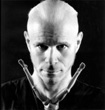 |
«Program
4: Dance Legends: Merce Cunningham» and «Program
5: Dance Film Artist in Focus: Charlie Atlas»
are two evenings with Charles Atlas.
Throughout his over 30-year career, Charles Atlas has made pioneering
media/dance works, multi-channel video installations, feature-length
documentaries, video art works for television, and live electronic
performances. His works oftentimes are challenging the “standard”
in relation to both content and technology. Besides Charles’
collaborations with Merce Cunningham, Charles has worked with
many remarkableartists
of his time –

|
Michael
Clark (Scotland), Karole Armitage (New York), Douglas Dunn (New
Zealand), Phillippe Decoufle (France), Mikhail Baryshnikov (USA)
among others. He is the 2006 recipient of the Foundation for Contemporary
Art’s biennial John Cage Award and of three “Bessie”
(New York Dance and Performance) Awards. Program 4: Dance Legends:
Merce Cunningham is at House of Cinema includes “Merce
Cunningham: A Lifetime in Dance”, a feature
documentary – both personal and historic portrait of the
master. "Program 5: Dance Film Artist in Focus" is the
second evening with Charles at ProArte. At ProArte, Charles Atlas
will discuss and screen numerous excerpts from films and videos
that he created throughout his prolific career. “As
seen on TV” (25min, 1988, USA) with the
world renowned mime and comedian Bill Irwin will be shown in its
entirety. Excerpts from “Parafango”
(1984) (with Phillip DeCoufle, Michael Clark, Karole Armitage),
“Superhoney” (1994), “Oh, Misha” (1999)
(a birthday present for Mikhail Baryshnikov), “Because We
Must” (1989) (with Michael Clark) and many
others will be part of the program.
«Program
6: Beyond the Stage: RIZE by David LaChapelle (2005)»
is the very occasion to glimpse in to the world of krumping.
David LaChappelle reveals a groundbreaking dance phenomenon that’s
exploding on the streets of South Central, Los Angeles. Taking
advantage of unprecedented access, this documentary film brings
to first light a revolutionary form of artistic expression borne
from oppression. The kids use dance as an alternative to gangs
and hustling: they form their own troupes and paint their faces
like warriors, meeting to outperform rival gangs of dancers or
just to hone their skills. “Clowning” or “Krumping”
becomes their way of life. The film features mind-blowing, athletic
movement performed at near impossible speeds – “a
visual miracle” (Rolling Stones Magazine).
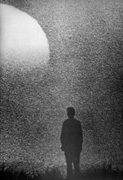 |
Traditionally,
KINODANCE presents several programs on dance film history.
The two historic programs this year reveal entirely opposite worlds
of dance and film collaborations – the one of Hollywood
with the «Program
7: Gene Kelly» and the other
of American avant-garde cinema with the «Program
11: Ed Emshwiller». If Gene
Kelly does not need a special introduction to
the Russian audience, as there is probably not a single person
unfamiliar with his stunning musical “Singing in the Rain”,
the name of Edmund Alexander Emshwiller
(1925-1990) will puzzle even Russian cinema connoisseurs. Ed Emshwiller,
named by Jonas Mekas “a madman who wants to become a camera”
began as a science fiction illustrator and a painter and later
turned into a filmmaker, a cine-choreographer, an intermedia artist,
a teacher, and an advocate of avant-garde cinema! Emshwiller’s
creative talent and devotion reflected in everything he did in
life. Most all of his personal films (except for “Relativity”)
Emshwiller financed himself, by working as a director of photography
on many commercial productions. He was such a desired cameraman
that Stanley Kubrik invited him to work on “2001: A Space
Odyssey”. Emshwiller declined the offer as he had commitments
to his personal work at the time. He loved, however, to collaborate
with different artists. “Emsh” worked with Alwin
Nikolais (films “Totem” (1963) and “Chrysalis”
(1973)) and Pilobolus dance company (film “Pilobolus and
Joan” (1973) and also took part in multimedia Happenings
of the 1960s. He was one of the first artists
(along with Trisha Brown) who brought on stage and mobilized the
film projector. Dancers physically manipulated the projectors
and treated them as partners during the stage performances. Multiple
projections and physical layering of images in real time (as opposed
to post-production) became signature in his work. One of Emshwiller’s
most successful multimedia performances is considered “Body
Works” (1965-66) where he used 5 projectors, 3 of which
were directed at dancers in white. The KINODANCE program dedicated
to Ed Emshwiller includes 6 films that will be all shown on 16mm
– “Dance Chromatic”
(1959), “Lifelines” (1960), “Thanatopsis”
(1962), “Totem” (1963), “Film With Three Dancers”
(1970) and “Relativity” (1966). I
would like to thank Christiana Galanopoulou, curator of
Videodance Greece Festival, for co-curating this program with
me.
«Program
7: Gene Kelly» includes a documentary “Gene
Kelly: Anatomy of a Dancer” by Robert Trachtenberg.
The film is both an intimate and historic look into the professional
and personal life of the visionary artist who revived the movie
musical and redefined dance on screen, bringing with him an inspired
sensibility and an original vitality. Kelly’s story is told
with great visual retrospective, the still familiar music and
through colleagues and protégés such as Debbie Reynolds,
Cyd Charrise, Leslie Caron and Betsy Blair, his first wife, and
their children.
 |
«Program
8: Performance Art in Motion» is an attempt
to bridge between cine-dance and performance art – to bring
forth body language, gestural expression, and acts of body ritual.
The program features two films wherein performance artists Meredith
Monk (born in Peru, living in New York) and Marina
Abramovic (born in Yugoslavia, living in Europe)
are the ones to either shape the film (Meredith Monk) or transcend
film’s story (Marina Abramovic) . “Book
of Days” by Meredith Monk (who is also a
world-renown composer featured in Peter Greenaway “Four
American Composers” series) draws parallels between the
Middle Ages – a time of war, plague and fear of the Apocalypse,
with our modern times of racial and religious conflict, AIDs,
and the fear of nuclear annihilation. It is a choreographic essay
written through the pedestrian movement of its characters, their
voices and their stories.
“Balkan
Baroque” by Pierre Coulebeuff is an experimental
fiction – both real and imaginary world of Marina
Abramovic, a world-renown body artist. The film
composes the life aesthetic of a woman in her era, with a personal
history strongly marked by the Yugoslavia of Tito, everyday violence
and the experience of physical and psychic limits. The film jumps
from one identity to another, from a true story to an imagination,
from a dream to a ritual – the language of the body often
taking over from the word, interrupting it or, on the contrary,
stimulating it.
 |
«Program
9 and 10: From the Festivals Around the World»
includesrecent works from all over the world. Among films in Program
9 – an intense short from Canada
“Hunt” (2005) by Marlene Millar and Philip Szporer
– exploration of the hunter’s anatomy and of the transformation
that occurs inside - calmness, pressure, extreme tension, consequence
of the hunt“; Wim Vandekeybus’
“Blush” (2005, Belgium) – premiered
at Cannes Festival, this film a dazzling voyage, an exploration
of the savage subconscious, of mythical forests, of conflicting
instincts, of imagination, where the body has reasons unknown
to the mind; and “Love Sonnets”
by Thierry and Michèle De Mey (Belgium),
although from far 1993, this film, never seen in Russia, remains
a true screen choreography masterpiece wherein words are swapped
for movement in tune with Scarlatti’s sonatas for harpsichord
and traditional aria from Southern Italy.
Program
10 includes: "Break”
(2005, New Zealand) – a new dance narrative
piece by Shona McCullagh (known
to the Russian audience that saw her exquisite short “Fly”
and perhaps, her choreography for such films as «The Lion,
the Witch and the Wardrobe» and «King Kong»);
En-Knap’s “What are
you going to do when you get out here?” (Slovenia, 2005)
is yet another poetic reincarnation (after “Dom Svobode”)
of the working-class town of Trbovlje, a hometown of En-Knap’s
choreographer Iztok Kovac and the main source of his inspiration.
Athletic dance, moody light, and actor’s lines choreograph
the film into a coherent stream of consciousness that amalgamates
past and present into one; William
Forsythe’s and Thierry De Mey’s “One Flat Thing
Reproduced” (2006) – an adaptation
of Forsythe’s stage piece – an aesthetical beauty
of shapes, intensity of the movements and closeness to the dancers.
This new experience offers to the audience the possibility of
receiving this creation in a completely different way, outside
of a theatre.
 |
«Program
12: All Time Favorites» – a collection
of classic dance films that have captivated the audiences at past
KINODANCE festivals. Among the films are last festival’s
hit, a witty black comedy “Cost
of Living” (2004) by Lloyd Newson and DV8 from UK starring
magnificent David Tole; Peter Greenaway’s and Anna Theresa
De Keersmaeker’s “Rosa” (1992)
wherein elegance is mixed with aggressive décor; “Black
Spring” (2002) by Benoit Dervaux and Heddy Maalem (France/Nigeria),
winner of the Best Choreography for the Camera Award at the New
York Dance on Camera Festival 2003, this film questions our way
of looking at African bodies in movement – the choreography
interspersed with scenes of contemporary life in Africa, highlights
both the political and emotional sensitivities of modern African
dance; Shona McCullagh’s “Fly”
from New Zealand, a kinetic short, loosely based
on the ancient story of Daedalus and Icarus, describes through
the language of movement, the final moments before separation;
Iztok Kovac’s and Saso Podgorsek’s
“Dom Svobode” about the town of Trbovlje
in Slovenia contains some of the best dance film choreography
in the final breathtaking dance sequence on the mountains.
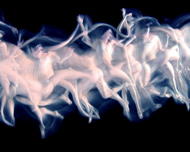 |
If
you look at running pedestrians or dancers on a rainy day through
a fogged window, you would not recognize people blurred by the
rain and the distance but you would clearly distinguish the trajectory
of their movement. Animated shorts and video art pieces (that
span from 1972 – 2005) in «Program
13: Film as a Plastic Art»
create movement and evoke dance-like feelings (at times, without
presence of the actual dancers) through a variety of techniques
– from traditional animation to morphing technologies.
Erica Russell’s Oscar-nominated, breathtaking “Triangle”
(1994) from UK expresses the passions of young
lovers and another woman through a dazzling frenzy of paint strokes
ranging from classical drawing to pure abstraction. The other
of Russell’s animated shorts in the program is
“Soma”. Inspired by street dance styles,
graffiti art and the paintings of New York artist Basquiat, this
film is about the fragmentation of identity and body image in
the chaos of the post-modern urban culture.
Rybchinsky’s “Kwadrat” made
12 years earlier echoes Russell’s “Triangle”.
It is ultimately a loop wherein a human figure is slowly generated
from a white square, colored and decomposed in space, generating
in turn other squares, which reunite, retransforming themselves
into the original white square. The
other Oscar nominated film in the program is the notorious “Tango”
by Zbigniew Rybchinsky (1980, Poland) –
a stunning use of cinema language to collapse time and space.
Thirty-six characters from different stages of life interact in
one room, moving in loops, observed by a static camera. Rybchinsky
drew 16,000 cell-mattes, and make several hundred thousand exposures
on an optical printer. Similarly elaborate and kinetic is the
black and white “La Piccola
Russia” (2004), a winner of the Best Narrative
Award at Ottawa Animation Film Festival.The film made it into
to the festival thanks to the generous support of TTV Festival
(Riccione, Italy). It is by the renowned Italian animator
Gianluigi Toccafondo
who captures still frames from the shot material, xeroxes them
on paper, paints on them and then re-shoots them on film. The
result is a multi-layered dance of paint and print strokes. The
film is also a narrative that traces the life of a young boy who
grows up to be a murderer. The two video art pieces from Gina
Czarnecki (UK) are “Infected” (2003) and “Nascent”
(2005). Both digitally manipulate the images of
the dancer(s) and explore the nature of the physical body in the
technological age. “Nascent”
morphs multiple dancers in motion reminiscent of Henry Matisse’s
“Dance”. The image processing creates new traces of
movement that appear as blips in transmission or digital ‘vibrations’
where the body and its image tune-in, momentarily, then become
‘unplugged’ leaving behind traces of skin-print as
after-images. The final film in the program, is "Ma
Mère l’Oye” (2004) – yet another exciting
dance film from Thierry De Mey and Anna Theresa De Keersmaeker
(Belgium). The film, inspired by Charles Perrault’s
famous fairy tales, segments the screen into multiples, choreographing
the dance in each one of them and between them according to the
musical motifs and orchestral moods of the ballet by Maurice Ravel.
 |
«Program
14: Choreography: Music Video» bridges between
choreography and music video. It is a diverse set of 19
spectacularly choreographed music video from 9 countries
that as a whole probably represent all possible formal concepts
and techniques of the dance film genre and choreography in cinema.
Split screens choreograph hands playing musical instruments in
Rupert Jones’ “100mph” by El Presedente (UK).
In “Let Forever Be”
by Chemical Brothers, Michel Gondry (US) pays
tribute to Busby Berkley, creating a dream sequence of a young
woman wherein seven identical dancers morph among each other and
with environments they encounter. The security guards burst into
a krumping-like movement in Futureshock’s
“Late at Night” (Japan/UK) while through
exquisite, kinetic editing, a basketball dances in the streets
of Budapest in Chemical Borthers’
“The Boxer”. Both videos are by NE-O
(i.e. Jake Knight and Ryoko Tanaka) based in UK.
The krumping session is also the center of Chemical
Brother’s “Galvinize” by Adam Smith (UK)
wherein a trio of young dance enthusiasts creeps past sleeping
parents and out onto the dance floor.
 |
Other
intense and disturbing works come from the UK – Unkle’s
“Rabbit in Your Headlights” by Jonathan Glazer
who choreographs cars to continuously kill the man in the underpass;
and Leftfield’s “Africa
Shox” by Chris Cunningham wherein an African
man runs through the streets of New York city losing parts of
his body while Afrika Bambaataa is chanting "The
world is on fire / It'll take you higher."
The program includes three videos from Spike
Jonze (USA): Wax’s “California”
(a mesmerizing long take of a man on fire, running along a city
street); The Pharcyde’s “Drop”
(a virtuosic trick when the group performed the video’s
actions entirely in reverse, even saying the lyrics backwards
so when the video was played forward, they and their mouths move
forward while their surroundings move in reverse – brilliant
screen choreography!), and finally Björk’s
“It's Oh So Quiet” (yet another homage
to Busby Berkley and perhaps, to “The Umbrellas of Cherbourg”
by Jacques Demy).
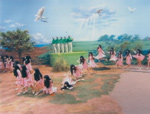 |
Yuki’s
“Sentimental Journey” by Nagi Noda
from Japan is a stop-motion piece that choreographs freeze-frames
in motion of 100 YUKI-looking people. The piece is truly in the
spirit of Eadweard Muybridge (1830–1904), an eccentric photographer
who gained worldwide fame photographing animal and human movement
imperceptible to the human eye. Carpark
North’s “Human” by Martin de Thurah (Denmark)
depicts the emotions of 10-12 year old kids who convey both fragility
and strength dancing and performing some impossible moves. Chemical
Brothers’ “Get Yourself High”
is an old kung-fu flick masterfully re-choreographed by Joseph
Khan (US) into a rap dance.
 |
“Montovedioaki”
by Octavio Iturbe (Spain), a winner of many dance
film festivals around the world, features Hiraki
Umeda, a Japanese choreographer and a dancer,
whose fluid movements clash with the urban landscape of Montevideo
(Uruguay). Mariana Arteaga’s
“Exile” from Mexico bridges into the
world of performance art, exploring the relationships between
the woman and the environment. Bjork’s
“All is Full of Love” and Squarepusher’s “Come
on My Selector” by Chris Cunningham (UK)
are examples of choreographed narrative. In Bjork’s case
it is a delicate and elegant dance of love between two Björk-looking
robots designed by Cunningham himself. “Come on My Selector”
is a tightly edited short episode in a Japanese childrens’
mental hospital that brings together a little girl who is a martial
arts master, a dog and two guards.
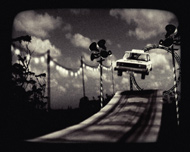 |
Elements
of booty, bling, kung fu, air guitar and almost every dance form
known went into the mix of “Theatre
of Speed vs BOZ’n’HOK” by Back To Back Theatre,
a pioneering Australian contemporary theatre company based in
Geelong, Australia. The
grand finale of the program is Phoenix
Foundation’s “Hitchcock” by Reuben Sutherland
(New Zealand) wherein electric cars clash with
their gas opponents in a road rage – they turn, fly, and
pirouette, reminiscent of fights in “Crouching Tiger, Hidden
Dragon”.
For
the second time, KINODANCE will hold a
Dance Film Competition for works created by artists from Eastern
Europe, Baltic States and the CIS. The jury of
Charles Atlas, David Hinton, Elena Kolovskaya (ProArte Institute),
Natalia Kasparova and myself will nominate 8-10 films out of the
submissions from Georgia, Armenia, Estonia, Russia, Hungary, Slovakia,
Poland, Romania, Ukraine, Belarus and other countries. These films
will be shown at the Closing Ceremony
of the festival on November 17 in St. Petersburg. The winner will
be also announced then.
I
hope that you come to enjoy the festival,
Alla Kovgan
International Director and Curator
KINODANCE, St. Petersburg
**
Please note, that Ekaterinburg and Moscow programs are a little
bit different, check schedule for
the line-up
©
Kinodance–Russia, 2006
akovgan@kinodance.com

